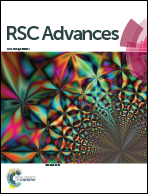Understanding the mechanism of replacement of citrate from the surface of gold nanoparticles by amino acids: a theoretical and experimental investigation and their biological application†
Abstract
The present study explores the physicochemical aspects needed for the appropriate in vitro synthesis and surface modification behavior of gold nanoparticles (AuNPs) in the presence of amino acids (AA). AAs replace citrate (Cit) from surface of citrate-coated AuNPs (Cit-AuNPs) depending upon their structural variations at different pH values. This behavior is further supported by molecular simulation studies, in which we have measured the effectiveness of different AAs in replacing the Cit from the gold (Au) surface. Within the limitations of the approach, the results indicate that cysteine (Cys) is most effective in replacing the Cit, arginine (Arg) is least effective, with glutamic acid (Glu) being intermediate. The UV-vis and FT-IR studies are employed to monitor the simultaneous synthesis and interactions of AA coated AuNPs over a range of pH values from 3.5 to 11. AA coated AuNPs are characterized by XRD and TEM studies. Cysteine coated AuNPs (Cys-AuNPs) show remarkable pH responsive behavior as compared to Glu and Arg coated AuNPs (Glu-AuNPs/Arg-AuNPs). Moreover, all AA coated AuNPs show little hemolysis with Arg-AuNPs having the least hemolytic effect. Thus, AA coated AuNPs are considered to be best vehicle for drug release and other biomedical applications.


 Please wait while we load your content...
Please wait while we load your content...